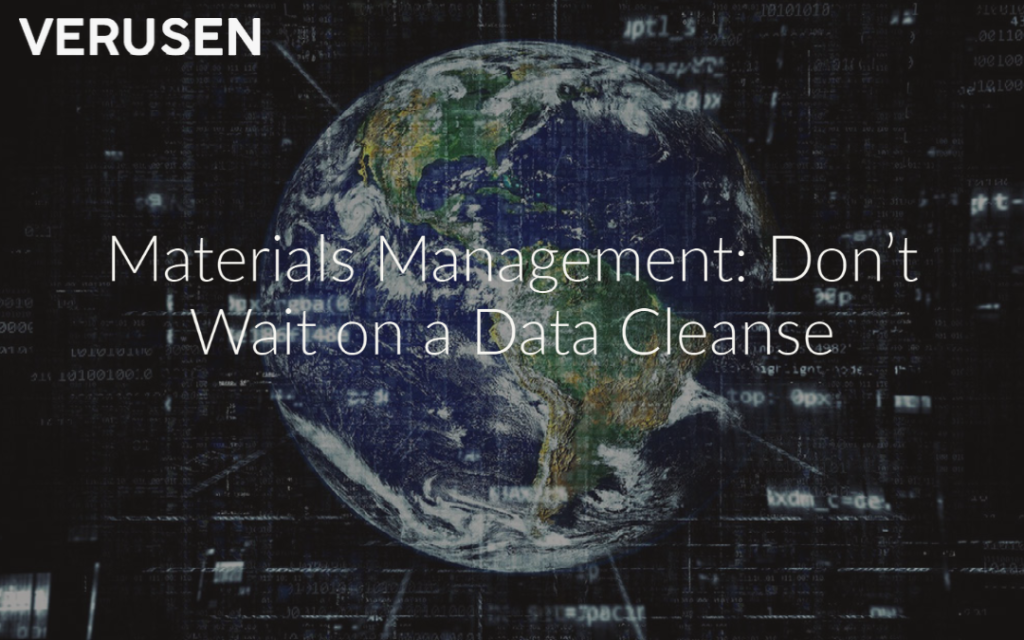Materials Management: Don’t Wait on a Data Cleanse to get Started

Materials Management has gone Digital
We can all agree – the world of supply chain optimization has changed. Most executives I speak with are either planning their digital transformation or in the middle of it. And why? Because that’s the only way to stay ahead of this tech curve that keeps accelerating. But you’ll notice I said most. Why do a few executives not have digital transformation at the front of their materials management strategy? Bad data.
Here’s the thing: if you are delaying your digital transformation due to bad data, you’re thinking about the problem with an outdated mindset. Over the next few weeks, I’m going to take a deep dive into what a materials management digital transformation project looks like and why a data cleanse doesn’t need to be step one.
What does bad data in a supply chain look like?
Disorganized. Duplicated. Disparate. Inaccessible (I really wish that last one started with a D). Bad data comes in a variety of shapes and sizes but the end result is the same. Inflated supply chain costs and increased risk. Worse still, you’re drastically limited in your ability to forecast future events (not that anyone could have predicted the Suez Canal) and therefore you’re forced to watch profits dip as you manage a continually growing inventory of obsolete, slow-moving or overstocked items. In fact – the average Fortune 500 manufacturer is carrying $50 million in wasted working capital specifically to counter bad data risks. Why? Because if they don’t, some unexpected catastrophe grinds manufacturing to a halt and deliveries are interrupted.
Dirty Data: Three Usual Suspects Holding Materials Management Hostage
The ERP System:
Now that we’ve established why executives think they need a data cleanse, let’s talk about the three typical sources of the issue. The primary offender? The central source of truth for most enterprises – their ERP systems – though it’s often inadvertent. Numerous employees or teams all entering data and extracting information leads to different understandings or uses of the platform. And because each team has different needs, they’ll also have different custom modules that might interact with each other in unexpected ways. Some of this can be prevented based on how the system is set up, but one aspect that a lot of ‘legacy’ supply chains share is their approach to security and that leads us to the #2 source of bad data.
Security:
This second source of bad data is the most glaring example of why a digital transformation is so important. Enterprises traditionally set up their ERP systems on-premise and disconnected from outside networks to be more secure and try and prevent a data breach. The problem? This also means the system is isolated from upgrades leveraging the latest advancements in technology, and can be especially clunky as companies grow through acquisitions. This can even lead to ERPs piling on top of each other, exasperating the problem. The end result is organizations not being aware of their own internal actions and in a lot of instances, variances within the teams. This takes us to the third and final suspect – us, the employees.
Employees:
No one wants to be a bad data offender, but it’s so easy to do and so hard to catch in a global organization. Inventory Data Management is defined by the capabilities of it’s given ERP system – though it’s ultimately going to be constrained by the human factor. Every system starts with data input and when you have an input, you have the potential for inconsistencies and errors. For example, without clear data management practices or data restrictions, employees might not consider how other colleagues, teams, divisions or facilities might reference and search for a specific item. This can lead to a variety of naming conventions getting in the way of clean data (bearing 12a vs BRG 12A). As I mentioned earlier, this leads to companies carrying enormous amounts of excess without realizing it simply because they don’t know they’re doing it.
And I don’t need to do a Data Cleanse?
That’s the thing – you don’t need to approach a data cleanse like you would have in the past. That’s the beauty of a digital transformation. AI-based solutions that many forward-thinking organizations are utilizing to optimize their materials management systems automatically clean dirty data as they work through inventory and provide true, accurate recommendations for data and inventory adjustments. This bypasses massively expensive projects that would have been crucial just five or ten years ago.
